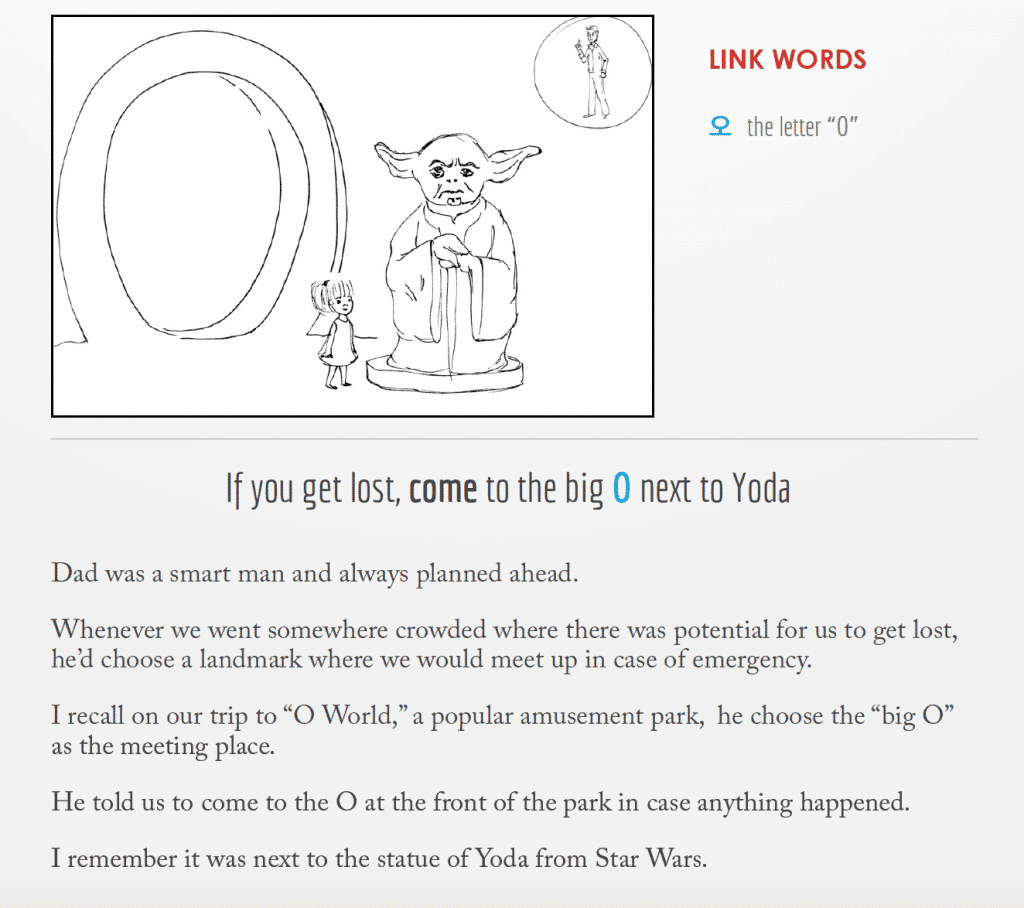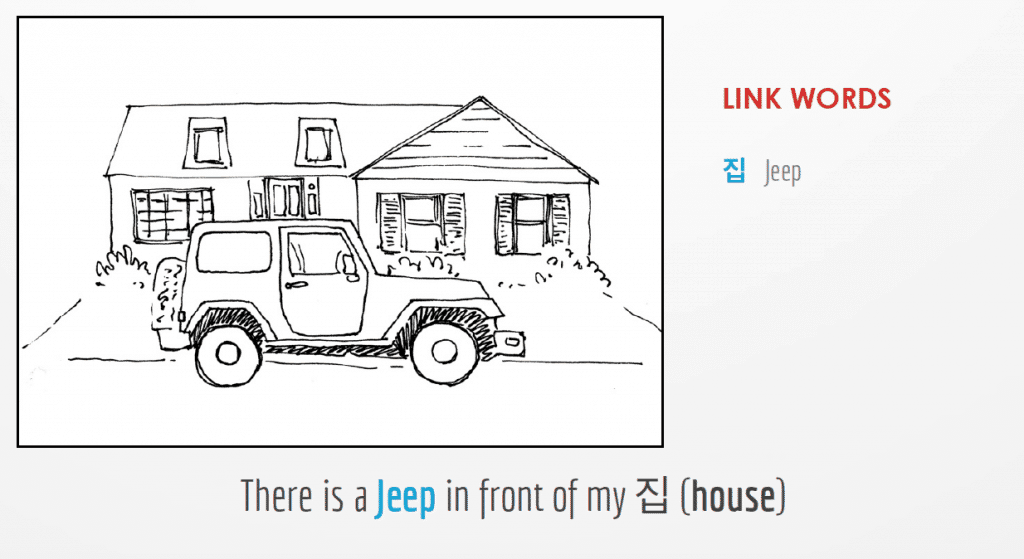Background on Remembering Korean Words
Have you ever studied a list of words in a new language and seemed confident you knew them, but when it came time to recall those words in a make-or-break situation of real life conversation, you couldn’t recall the word?
If so, you know that recognition does not equal recall.
Training for recall is seen as much more difficult than recognition, but it doesn’t need to be that way. World record holders in memory contests have even claimed that those of average IQ could easily use the same memory techniques and mnemonic devices to win world records themselves.
In this guide, we’ll present you with stories and images you can use these to improve your recall of common Korean words.
The Korean Word Memorization Pack was born out of necessity after hundreds of students requested an easier way to learn Korean vocabulary.
Relying on rote memorization to learn Korean vocabulary is challenging. The words and sounds of Korean can sound like gibberish in the beginning to speakers of other languages.
Repeating the words over and over in your head doesn’t help them stick. It’s possible to memorize them, but when it comes time to recall them, you will be stuck. This is the most common method utilized by language learners. When there’s a new vocabulary word to learn, they try to force its memorization through rote repetition.
For example, imagine you had the Korean word 이름 (i-reum) on your list of words to remember. A typical student might simply repeat this word over and over in their head:
“이름 – name, 이름 – name, 이름 – name,” and so on.
While this can be successful in creating a memory, it is not practical because a) it takes an inordinate amount of time, and b) no deep connections are formed in the brain that allow for recall.
Ever heard the phrase “A picture is worth a thousand words?” It is indeed true. If you compared your brain’s ability to memorize the details in a picture with its ability to remember those same details verbally, you’d notice the brain can much more easily remember visual cues.
The problem lies in the fact that it takes very little time to write down a word than it does to sit down, generate an association and produce a visual image. Visual images greatly reduce your learning time, but they also take a long time to create.
The mnemonics in this guide will allow you to save hundreds of hours of rote memorization.
After learning the words, the next step is application in real conversations!
Please note, this guide assumes knowledge of Hangeul (the Korean alphabet).
If you can not yet read Korean, you may download a free lesson here.
Let’s get started!
How to Remember Korean Verbs
CLIPS™ Process by 90 Day Korean This technique involves creating mini “movie clips” in your mind. When you force your brain to create visuals for the information you’re reading, you create a much deeper association. It’s like reading a book versus watching a movie. When you read a book, your mind is forced to create visuals for the information you’re reading and you create much deeper associations in your mind.
However, when you watch a movie, the action is much more passive since the director has already imagined how everything should look and presents it to you visually. No imagination is needed.
In this sense, using the CLIPS™ Process to learn Korean words is like reading a screenplay to a movie! You can picture the action taking place yourself.
We can use the CLIPS™ Process to memorize Korean verbs.
The process involves 5 steps:
1) Classify
2) Link
3) Invent
4) Picture
5) Say
Step 1: Classify
1. Classify the word – Is it a 다 verb or a 하다 verb?
2. Remove the verb ending
Step 2: Link
1. Break down the verb root into syllables or pieces (if applicable)
2. Find link words and create associations
Step 3: Invent
1. Create a back story to go with the link words
2.Add personal memories and extra details to the story
Step 4: Picture
1. Imagine the scenario in your head, noting if it’s a 다 verb or a 하다 verb
2.Draw a rough sketch
Step 5: Say
1. Say the back story aloud to help secure the memory
2. Rehearse the link words and the association
The CLIPS™ Process is made more powerful if you create your own stories. One of the most effective ways of enhancing your associations is by linking them to your personal life.
The examples we provide in this guide can be changed or tweaked however you see fit.
You can change the story, add extra background information to it, and associate it with a personal memory.
We encourage you to add more colorful details to the story. For example, if there is a man in the back story, truly visualize the situation add extra details like the color of the hat he is wearing, or what color his eyes are. The more detail the better!
In using the CLIPS™ Process, you’ll be learning Korean words bidirectionally! This means that when you go to use the words in conversation, you’ll not only be able to recall it yourself but you’ll be able to listen for the word and understand it when the other person uses it.
Instructions
So now it’s your turn.
For the following words presented in the guide, go through each step of the the CLIPS™ Process.
First, determine if the verb is a 다 verb or a 하다 verb.
Review the link words, and create the associations in your mind by creating a detailed mental picture. Read through the back story, and feel free to change it or create your own. Picture it in your head, and draw a sketch using the worksheets provided as part of the Korean Word Memorization Pack.
Finally, say the link words out loud.
Let’s get started. We’ll do the first one for you.
Korean Verb Association Example
오다 (oda) – To come

Now it’s your turn! Use the CLIPS™ Process to create associations for these five Korean verbs:
1. 가다 – to go
2. 먹다 – to eat
3. 마시다 – to drink
4. 공부하다 – to study
5. 운정하다 – to drive
How to Remember Korean Nouns
These are nouns, and just require a simple association. Back story is optional.
Go through them, learn the associations, and create your own back story and images if you wish.
Remember that real-life application will help solidify the associations.
Korean Noun Association Example
집 (jip) – house

Now let’s see what kind of associations you can create for these five nouns:
1. 작가 – writer
2. 선수 – athlete
3. 연필 – pencil
4. 문 – door
5. 시계 – clock
Now that you know how to make associations for Korean words, spend some time creating your own stories. The small amount of time investment up front will help you learn Korean fast!
 Learn to read Korean and be having simple conversations, taking taxis and ordering in Korean within a week with our FREE Hangeul Hacks series: http://www.90DayKorean.com/learn
Learn to read Korean and be having simple conversations, taking taxis and ordering in Korean within a week with our FREE Hangeul Hacks series: http://www.90DayKorean.com/learn
Korean lessons * Korean Phrases * Korean Vocabulary * Learn Korean * Learn Korean alphabet * Learn Korean fast * Motivation * Study Korean


Recent comments